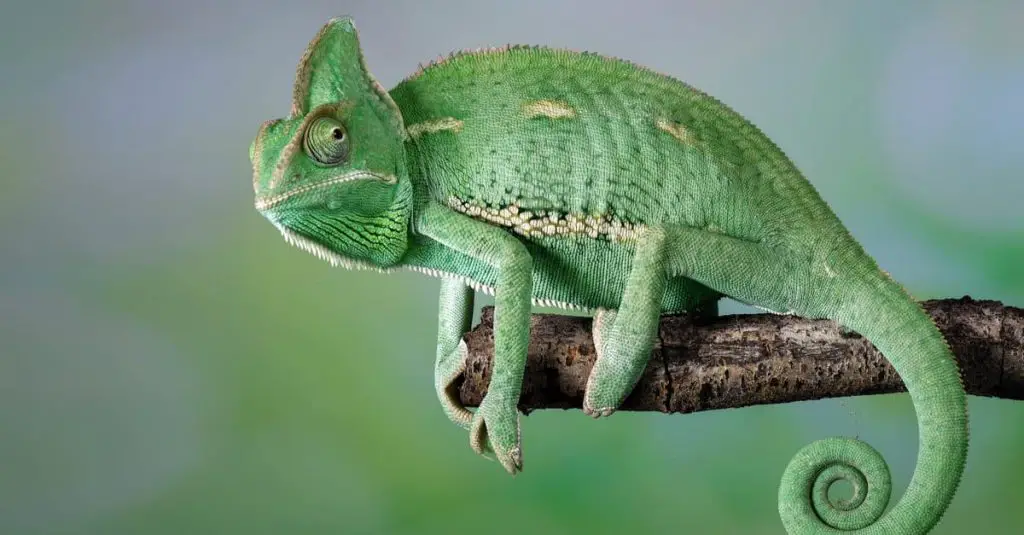Chameleons are fascinating creatures that are known for their remarkable ability to change color. But, how are these reptiles different from other members of their class? In this article, we will explore the unique characteristics that set chameleons apart from other reptiles and delve into their fascinating world.
Unlike other reptiles, chameleons have a prehensile tail that can grasp onto branches and other objects. They also have independently rotating eyes that allow them to look in two different directions at the same time. These adaptations help chameleons to be successful hunters and avoid becoming prey themselves. Let’s take a closer look at the intriguing world of chameleons and their distinctive features.

How Are Chameleons Different From Other Reptiles?
Chameleons are one of the most fascinating and unique creatures in the animal kingdom. They are known for their ability to change color, their long, sticky tongues, and their distinctive eyes. While they are classified as reptiles, chameleons are quite different from other reptiles in many ways.
Physical Characteristics
Chameleons have a unique physical appearance that sets them apart from other reptiles. They have prehensile tails that can grip branches, allowing them to climb and move around with ease. Their feet are also specially adapted for climbing, with two toes pointing forward and two pointing backward. This gives them a firm grip on branches and other surfaces.
One of the most distinctive features of chameleons is their eyes. They have independently moving eyes that can move in different directions at the same time. This gives them a 360-degree field of vision, allowing them to see predators and prey from all angles. Chameleons also have long, sticky tongues that are capable of reaching out and grabbing insects from a distance.
Diet
Unlike other reptiles, chameleons are strictly carnivorous. Their diet consists mainly of insects, although some larger species may also eat small vertebrates such as lizards. Chameleons are ambush predators, using their camouflage and stealth to sneak up on their prey before striking with their tongues.
Chameleons are also known for their slow metabolism. They may only eat a few times a week, and they can go for long periods without food or water. This is because they have adapted to living in environments where food and water may be scarce.
Behavior
Chameleons are solitary creatures, preferring to live alone rather than in groups. They are also territorial, marking their territory with scent and defending it from other chameleons. They are generally slow-moving and tend to spend most of their time sitting still, waiting for prey to come within range.
One of the most unique behaviors of chameleons is their ability to change color. They do this for a variety of reasons, including communication, camouflage, and temperature regulation. Chameleons have specialized cells in their skin called chromatophores that allow them to change color.
Habitat
Chameleons are found in a variety of habitats, from rainforests to deserts. They are most commonly found in trees, where they are able to climb and move around with ease. Some species of chameleons are adapted to living in harsh desert environments, while others prefer the humid and moist conditions of the rainforest.
Chameleons are also able to tolerate a wide range of temperatures. Some species are able to survive in temperatures as low as 40 degrees Fahrenheit, while others can tolerate temperatures as high as 100 degrees Fahrenheit.
Breeding
Chameleons have a unique reproductive system that sets them apart from other reptiles. Females are able to store sperm for long periods of time, allowing them to fertilize their eggs when conditions are favorable. They may lay as few as 10 eggs or as many as 80, depending on the species.
Chameleons are also able to change color during mating rituals. Males will often display bright colors and patterns to attract females, while females may change color to signal their receptiveness to mating.
Benefits of Chameleons
Chameleons play an important role in their ecosystems as predators of insects and small vertebrates. They also have unique adaptations that make them well-suited to their environments, from their prehensile tails to their independently moving eyes.
Chameleons are also fascinating creatures to observe and study. Their ability to change color and their unique physical characteristics make them a popular choice for pet owners and researchers alike.
Chameleons vs. Other Reptiles
While chameleons are classified as reptiles, they are quite different from other reptiles in many ways. Unlike most reptiles, chameleons are strictly carnivorous and have a slow metabolism. They also have a unique reproductive system and are able to change color for a variety of reasons.
In terms of physical characteristics, chameleons have prehensile tails and feet adapted for climbing, as well as independently moving eyes. They are also able to tolerate a wide range of temperatures and are found in a variety of habitats.
Overall, chameleons are a fascinating and unique group of reptiles that continue to capture the imagination of scientists and animal lovers alike.
Frequently Asked Questions
How are chameleons different from other reptiles?
Chameleons are unique in many ways compared to other reptiles. One of the most noticeable differences is their ability to change color. Chameleons can change their skin color to blend in with their surroundings or to communicate with other chameleons. They also have long, sticky tongues that they use to catch insects. Chameleons have independently movable eyes, which allows them to look in two different directions at the same time. They also have prehensile tails that they can use to grasp onto branches and other objects.
Another significant difference between chameleons and other reptiles is their feet. Chameleons have zygodactyl feet, which means they have two toes pointing forward and two toes pointing backward. This unique foot structure allows them to grip onto branches and climb effectively. Unlike most other reptiles, chameleons are not great swimmers and prefer to live in trees and shrubs.
Overall, chameleons are fascinating creatures with unique adaptations that set them apart from other reptiles.
How do chameleons hunt their prey?
Chameleons are insectivores, which means they primarily eat insects. To hunt their prey, chameleons use their long, sticky tongues. When a chameleon spots an insect, it will slowly move its eyes to focus on the target. Once the chameleon has a clear view of the insect, it will extend its tongue at incredibly high speeds. The tongue is coated in a sticky mucus that traps the insect, and the tongue will retract back into the chameleon’s mouth, bringing the prey with it.
Chameleons are patient hunters and will wait for the right opportunity to strike. They will often sit motionless for long periods, waiting for an insect to come within range. Chameleons also have excellent eyesight and can see both near and far objects in great detail. Overall, chameleons are skilled hunters that use a combination of stealth, patience, and precision to catch their prey.
What is the lifespan of a chameleon?
The lifespan of a chameleon varies depending on the species and their living conditions. In the wild, chameleons typically live for 5-10 years. However, in captivity, some chameleons have been known to live for up to 20 years or more. Proper care and nutrition are essential for chameleons to reach their full lifespan potential.
Several factors can affect a chameleon’s lifespan. For example, stress, disease, and poor nutrition can all shorten a chameleon’s lifespan. Conversely, providing a healthy diet, proper lighting, and a suitable living environment can help extend a chameleon’s lifespan. Overall, the lifespan of a chameleon can vary greatly, but with proper care, they can live a long and healthy life.
How do chameleons communicate with each other?
Chameleons communicate with each other using a variety of methods. One of the most common ways is through body language. Chameleons will change their color to communicate with other chameleons or to express their mood. For example, a male chameleon may turn bright colors to show aggression towards another male.
Chameleons also communicate through physical gestures. They may bob their head, puff up their throat, or display their dewlap (a flap of skin near their throat) to signal to other chameleons.
Finally, chameleons also use vocalizations to communicate. Though chameleons are not known for their vocal abilities, they can make a variety of sounds, including hisses and chirps. These sounds are used to attract a mate, warn of danger, or establish dominance. Overall, chameleons have a complex communication system that allows them to interact with each other effectively.
Are chameleons social animals?
Chameleons are not social animals and prefer to live alone. In the wild, chameleons will only interact with other chameleons during mating season or when competing for territory. They are solitary creatures that spend most of their time alone in trees or shrubs.
In captivity, chameleons may show aggression towards other chameleons if they are housed in the same enclosure. It is generally not recommended to keep multiple chameleons together, as it can cause stress and aggression. Overall, chameleons are solitary animals that prefer to live alone and interact with other chameleons only when necessary.
WHAT HAPPENS IF CHAMELEON SEES A BEARDED AGAMA? CHAMELEON vs LIZARD
In conclusion, chameleons are a unique and fascinating type of reptile that stands out from the rest. While many other reptiles are known for their tough skin and sharp teeth, chameleons are recognized for their incredible ability to change color and blend into their surroundings.
One significant contrast between chameleons and other reptiles is their distinctive eyes. Unlike other reptiles, chameleons have independently rotating eyes that allow them to look in two different directions at once. This feature enables them to track prey and predators with unmatched precision.
Another way that chameleons differ from other reptiles is their tongue, which is longer than their body and can shoot out at lightning-fast speeds to capture prey. Additionally, chameleons have prehensile tails that can wrap around branches and hold on tightly, which is not a trait shared by many other reptiles.
Overall, chameleons are a unique and fascinating reptile that is set apart from other reptiles by their distinctive characteristics and behaviors. Their ability to change color, independently rotating eyes, and specialized tongue and tail make them a fascinating creature to observe and study.


